Following our collaboration with Thrasher, Farran Golding spoke to Michael Burnett about his journey from aspiring photographer to editor-in-chief and the editorial schedule that puts Thrasher to print every month.

Words and interview by Farran Golding. Photography by Michael Burnett.
In the summer of 1986, Michael Burnett walked into a record store and found former Misfits frontman, Glenn Danzig peering out from the cover of a magazine. Alongside it, skateboarder Jesse Martinez was stretched out in a Judo air against a clear blue sky, almost entirely out of context. At this point, Back To The Future had been Burnett’s only exposure to ‘documented’ skateboarding and his first sighting of skating in printed form was also an introduction to the publication he’d one day helm, Thrasher Magazine.
“When you’re at that age, the images resonate and they’re so mysterious and magical. Then you read ‘em and a lot of the magazine was like a secret code. You’re a kid, trying to figure out how everything within this world works,” says Burnett. “In that jump-ramp era, there was a lot of running with a board in hand and jumping into the air. You couldn’t tell that’s how the skater had got there, you thought there was some way you could fly on these things that you didn’t understand. I rode a skateboard for a year before I saw an ollie.”
Skate videos were sparse and despite print being his gateway, circulation wasn’t strong either. “It was trying to find little scraps here and there. I remember I bought a copy of Freestylin’ – a BMX magazine that Spike Jonze, Jeff Tremaine and Megan Baltimore worked on, just because it had three skate photos in it,” laughs Burnett. “Trying to figure out the names of tricks, skaters – it’s mesmerising. Similar to how somebody could get engrossed in comic books, Dungeons & Dragons or heavy metal. You see glimpses and want to put the puzzle together but with skateboarding you’re out, riding around too. You’re not just thinking about it, you’re actually doing it.”
Towards the end of high school, Burnett’s dad got a new job in Denver, Colorado and as the family moved, he relocated to the neighbouring Boulder for university. “Colorado was the most fantastic time of my life. I went from Texas, where all my friends had basically quit skating by the time they were able to drive, to having more skateboarding friends than friends I’d had in my entire life.”
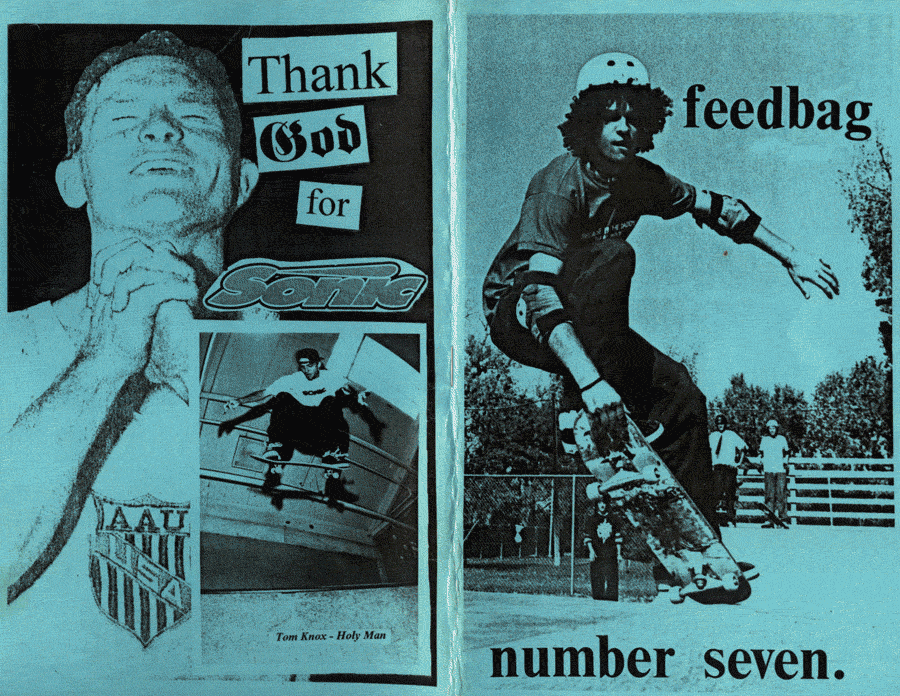
An issue of Burnett’s early zine, ‘Feedbag’ featuring photos of Tom Knox, Tony Hawk, Kareem Campbell and Built To Spill.
Initially enrolling in a history class, he became interested in making zines and his journalistic endeavours were strengthened after meeting Big Brother editor, Jeff Tremaine when the magazine staff passed through on a tour. “That was inspirational in terms of, “These are just regular guys. I can do this too,” says Burnett. Switching courses after realising the equipment that was accessible to journalism students – scanners, a darkroom, early Photoshop and InDesign’s predecessor, Quark, enabled him to continue producing zines. “This was before everybody had their own computer. Unless you were rich, you had to go where computers were available,” he says.
 Out of the friends he made through zine culture, one had somehow landed an article in Thrasher. “It was right up Jake Phelps’ alley. Shitty point and shoot photos with dumb captions. I asked how he’d done it and he goes, “I just called ‘em!”, says Burnett. “Now, I feel like kids know how to do everything but, back then, the idea that you could do something for Thrasher, or any magazine, seemed ludicrous. Like you needed permission or an invitation. So I called Jake and asked if I could do a Colorado article. It passed muster, somehow, but I look at it now and it’s full of the things I tell people not to do. They gave me a shot and that was awesome.” His debut article, ‘Mile High Melee’ ran in November 1994.
Out of the friends he made through zine culture, one had somehow landed an article in Thrasher. “It was right up Jake Phelps’ alley. Shitty point and shoot photos with dumb captions. I asked how he’d done it and he goes, “I just called ‘em!”, says Burnett. “Now, I feel like kids know how to do everything but, back then, the idea that you could do something for Thrasher, or any magazine, seemed ludicrous. Like you needed permission or an invitation. So I called Jake and asked if I could do a Colorado article. It passed muster, somehow, but I look at it now and it’s full of the things I tell people not to do. They gave me a shot and that was awesome.” His debut article, ‘Mile High Melee’ ran in November 1994.
By the time he’d graduated university, Burnett had squeezed as much as he could out of his local scene. Thrasher offered him a job but, not keen on joining the ad department, he turned it down and stayed in semi-regular contact with Phelps until he was hit with a proposition out of the blue: move to Southern California and get put on a retainer. “The title they gave me was ‘SoCal Bureau Chief’ – which was also ridiculous – but Jake picked that out,” laughs Burnett.
“Here’s the thing that gave me the leg up: I always did complete projects. I always had a vision for what I was doing, not just, ‘Here’s a photo. Here’s a photo. Here’s a photo.’ I was always working on putting something together even if it was pretty simple.”
By the time photo editor, Luke Ogden left the magazine, Burnett already had a grasp on the wider operations of Thrasher. “I couldn’t help myself, I wanted to do it all day long. We never got a new photo editor, we still don’t have one, but I was kind of doing those jobs,” he says about becoming a formal editor-at-large. He spent 15 years in the role until Jake Phelps’ passing in 2019, inheriting the mantle of editor-in-chief from the friend who gave him his very first shot.
Today, if not out shooting photos, Burnett modestly describes his day-to-day with Thrasher as, “Picking out most of what makes up the magazine and working with the art department to get it to the finish line.” In summary of how he got there: “Basically, I bugged the shit out of everybody and always had an idea,” he chuckles.
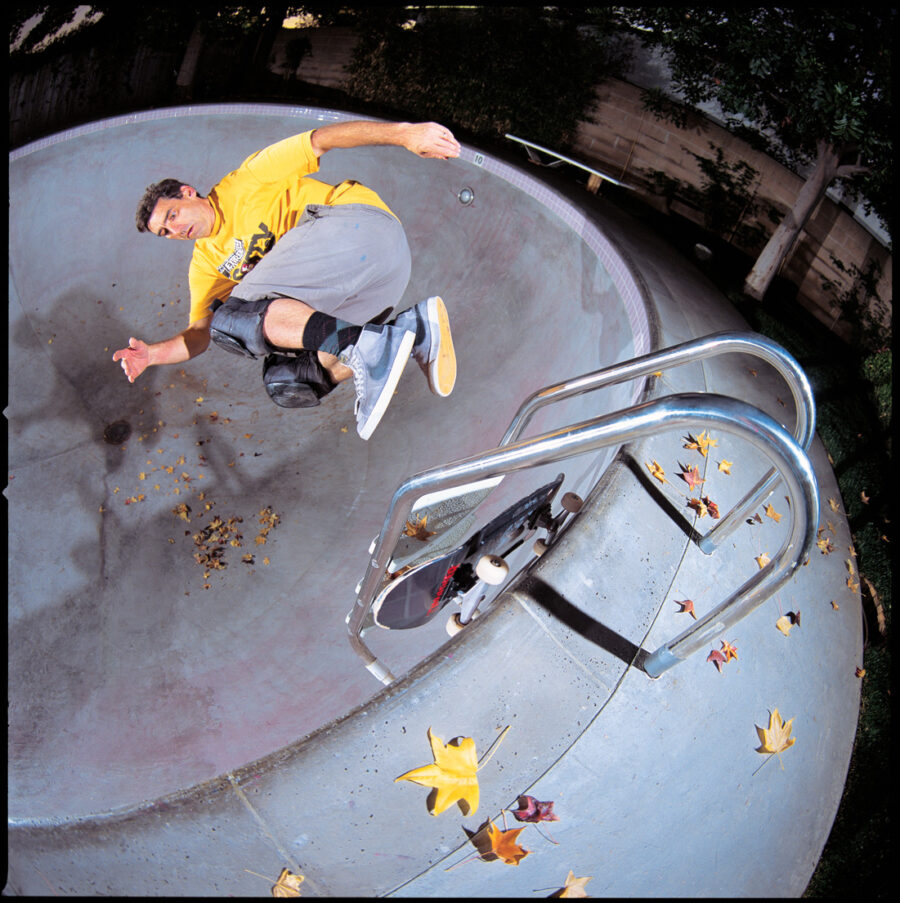
A key protagonist later in this story, Lance Mountain hippie jumps in 2008. Below: Jake Phelps and Spanky, 2010
“I enjoy every aspect of the magazine experience apart from dealing with disgruntled advertisers.”
Magazines usually have photo editors but occasionally a photographer takes on the role of editor-in-chief, like yourself. Do you see a difference of approach towards the position whether a person comes from a background in writing or photography?
From a fan’s perspective, Grant Brittain is a legendary photographer and he was always critical of Thrasher because our paper stock was bad. But The Skateboard Mag slowly devolved into just having captions for text even though they had some excellent writers so maybe there’s that: a magazine can become a picture book.
Jake, he loved photos and was steeped in the Skateboarder Magazine of the ‘70s which was a super visual thing mixed with a Hunter S. Thompson, gonzo journalism approach. He had a good grasp on it all. Photos aren’t easy but it’s all a dude flying through the air so to be the editor, you need a vision beyond that. It’s great to have multiple skills in the editor’s seat. Somebody who appreciates the writing, photography and design is best equipped to do the job.
“I can do that. And that. And that. And I’ll build a jump ramp for you.”
I enjoy every aspect of the magazine experience apart from dealing with disgruntled advertisers.
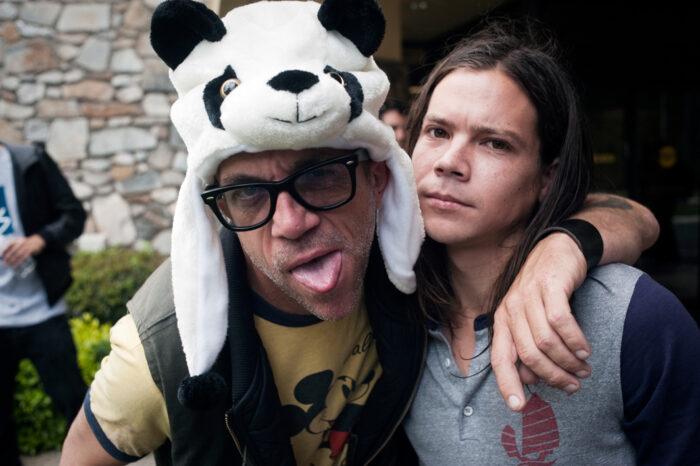 There was a real celebrity presence surrounding Jake and Thrasher, especially in later years. I find it hard to imagine him being the kind of editor-in-chief who enjoyed, or even did, chase final drafts.
There was a real celebrity presence surrounding Jake and Thrasher, especially in later years. I find it hard to imagine him being the kind of editor-in-chief who enjoyed, or even did, chase final drafts.
You’re not wrong. He brought a lot to the table and we complimented each other’s strengths. He did what he wanted to do. I’m more of a team player, get-shit-done kind of guy but I’m not the guy who can get an entire skatepark on their feet, screaming and setting things on fire.
It’s funny because he did a lot of things at the magazine. If you look at his ‘Product Patrol’ column, his first editorial job, you’d be dumbfounded Jake Phelps wrote that. It’s fully straight. He’s polite, diligent, he talks about wheelbases! Like, “How is this the same person?”
He evolved too. You can look at those magazines from when he was in the driver’s seat, and see touchstones of what he really liked. He went around the world three times with a point-and-shoot camera, taking photos of dudes on a quarter pipe. He could be charming, he could be the genius and he could be a complete mess but it was never boring and he was one of those irreplaceable people. You can’t fake that.
He was a force of nature but he wasn’t copy editing [laughs].

Geoff Rowley – 360 flip to lipslide, 1999. Below: 5050, Lyon, 2001.
“The early 2000s was like a progression war.”
When print media was peaking in the 2000s, how much rivalry was really there between Thrasher and TransWorld?
In all honesty, I got the job when Thrasher was at its shittiest. They gave me a chance because I don’t think they had a lot of suitors. Those first few years I was at Thrasher, TransWorld was 400 pages and made the best videos in skateboarding. I’d open those magazines and be filled with dread. My thought was, “We will never catch up to this.”
A huge part of my motivation was catching up. Basically, having better tricks and better covers. The early 2000s was like a progression war. My motivation was to be out there, getting as many of those photos as I could and when I had the photo of the last trick of a TransWorld video, I was stoked.
There’s an irony in how TransWorld pioneered the magazine-made video to later be knocked out the ballpark by Thrasher as the platform for online videos.
This is a big part of Tony Vitello’s rise at the mag. Tony is the son of Fausto, who started Thrasher. Shaping the website, that’s where he really took the lead, started wrangling that material and had a drive to make that happen. It slowly turned into the magazine and the website video as a package where you got to have your Thrasher interview and your part came out on the site. There wasn’t a dry erase board with all that planned out. Everything we’ve done has been constantly trying to reevaluate what we’re doing. It’s not just a case of, “What’s good business?” but “What would be cool?”
It’s just how online unfolded and we were ready. Tony has made a lot of contribution to the program, but getting the web video up and running to where it is today has been huge. It’s interesting to think about the evolution of that. We’ve done a lot of full-lengths too but it’s turned into a video machine, as far as trying to keep the pace with print and videos driving our editorial schedule now. Every month, the first question is, “What videos are coming out so we don’t have to burn these fucking photos?” If someone is going to take the time to pick up and buy a magazine, I want to give them as many surprises as possible.
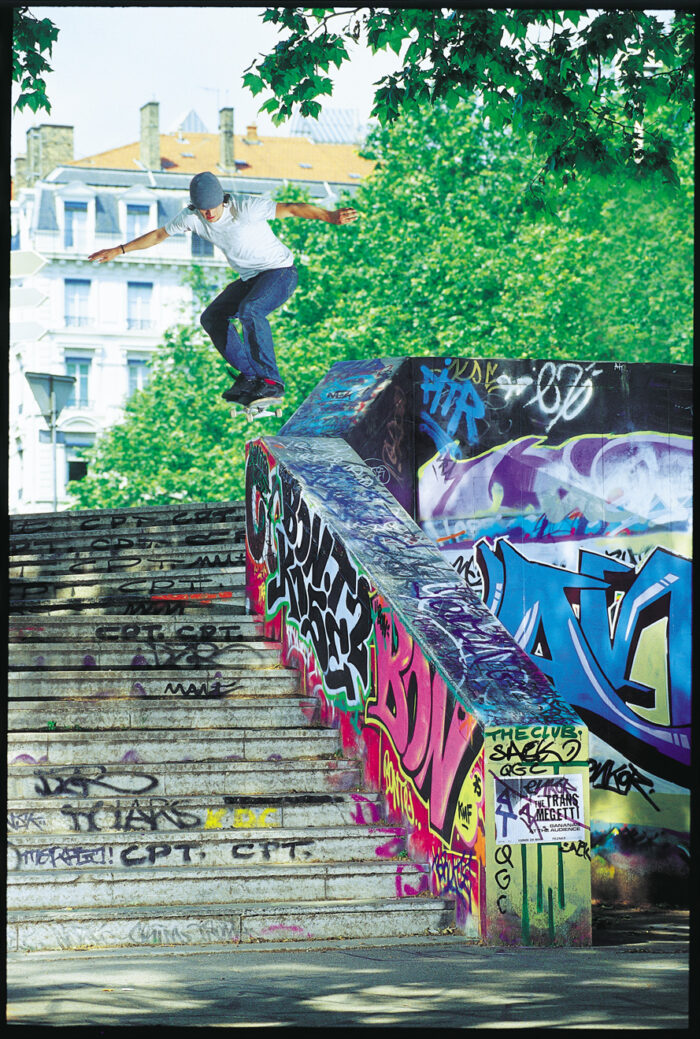 Earlier you talked about the “package deal” being part of what you brought to the table for Thrasher. Is forging long standing relationships between the mag and certain skaters an extension of that?
Earlier you talked about the “package deal” being part of what you brought to the table for Thrasher. Is forging long standing relationships between the mag and certain skaters an extension of that?
It is for me. Also, that’s how I got past TransWorld. When I got the job, the pros were my age so I reached out to those guys and I had very poor success rates [laughs].
It started by connecting with the next group. Geoff Rowley reached out to me big time because he loved Thrasher. That was huge. With that, I got Ed Templeton and his guys. Then Jamie Thomas really wanted to get back in Thrasher. He couldn’t stand that he wasn’t in the mag for whatever reason so those were all big ones.
After that, it was connecting with the next wave. Jon Allie, Shane Cross, Billy Marks – I met them as teenagers and got them their first photo in the magazine all the way up to a cover.
It’s more than a business strategy. You work with people, keep it going, build a relationship so when they have videos, there’s a time to do something because you know these guys. The only way my career took off was through building those relationships. At the same time, maybe the other magazines were more comfortable and, as a result, I had the hot shit because I was out with the new guys all the time.
All that stuff is natural, it all builds on itself as different opportunities and positive experiences. They might go off, do something else for a while, do Street League and we might never see them again, but most of them we will because they’ve made a connection with Jake or I. It’s like, “Oh, these are our guys. Thrasher guys.”

Elissa Steamer, frontside 5050, 2008. Below: Corey Duffel, 2001.
“I didn’t wear the Corey Duffel pants but I like that people did. Because it’s like, “Oh, you’re trying to be a skater. You’re trying to be your own thing.”
After helping build your fair share of careers, do you think skateboarders can achieve the same mysticism and mythology as those who became established, pre-internet?
That’s interesting. There are still skaters that you want to know more about, that you’re excited about. I’m not worried about it, and it’s going to work itself out, but I don’t know if people are going to still have those twenty-year careers. I don’t know how you can build a Gino Iannuci-esque mythology. It’s going to happen in some ways but you see what kids are doing today and it is like a grab bag of excitement.
The other day, I was like, “Why is everyone dressed like an eighth grade slob from 1989?” – except nobody in those days would’ve tucked their t-shirt into their jean shorts [laughs]. But that’s cool. I like anything “freaky” that kids are doing to be weird. I didn’t wear the Corey Duffel pants but I like that people did. Because it’s like, “Oh, you’re trying to be a skater. You’re trying to be your own thing.”
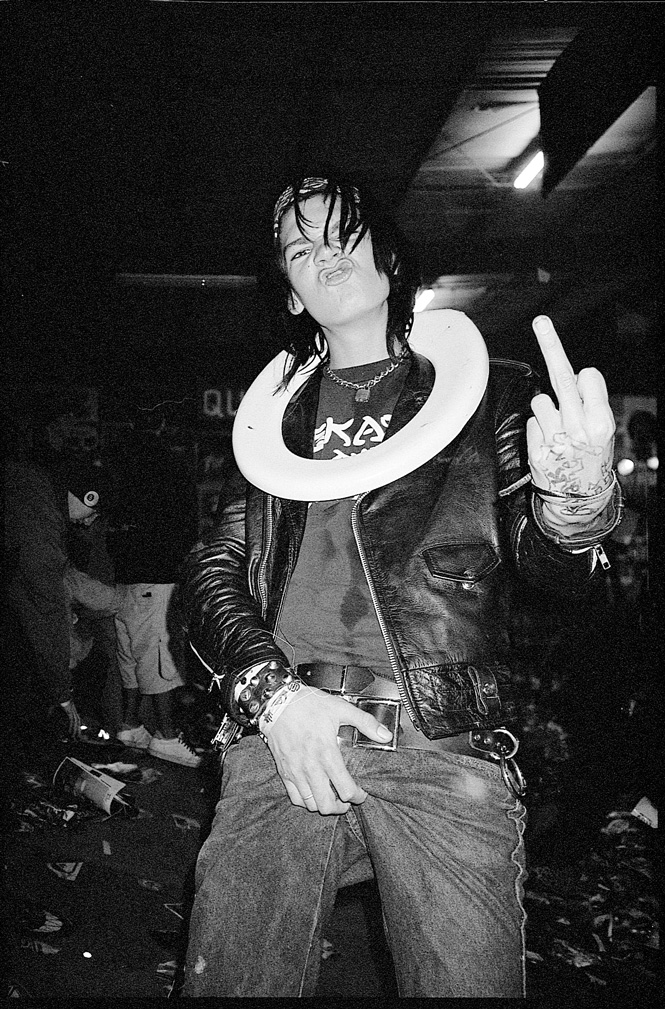 What’s the wildest misconception about Thrasher that you’ve come across?
What’s the wildest misconception about Thrasher that you’ve come across?
That people buy ‘Skater Of The Year’. The funny thing you realise, once everyone’s opinions were given a platform, is that those of us who us were paying attention to every detail of skateboarding have been, and still are, a very small group of
nerds.Then it’s wild world of dumb ideas out there.
We get a lot of solicitors, people looking for modelling contracts.
“I want to be a Thrasher model.”
“I don’t know what you’re talking about…”
There’s people’s idea of success and how they’re going to “make it” – a lot of confused motherfuckers who look at Instagram and have some skewed idea of the universe and what skateboarding is going to get you. Even newer pro skaters ask me questions which makes me think, “Are you crazy?”
I had an agent call me – a person who represents pro skaters. And it was clear after the first few minutes of conversation that they didn’t understand what an ad was.
“How do you decide who gets the ads?”
“They’re bought…”
This adult who is “in charge” of peoples’ careers didn’t understand what an advert is. They thought it was some bonus editorial with a company name on it that we created. As far as misconceptions, throw a nerf football and you’ll hit one [laughs].
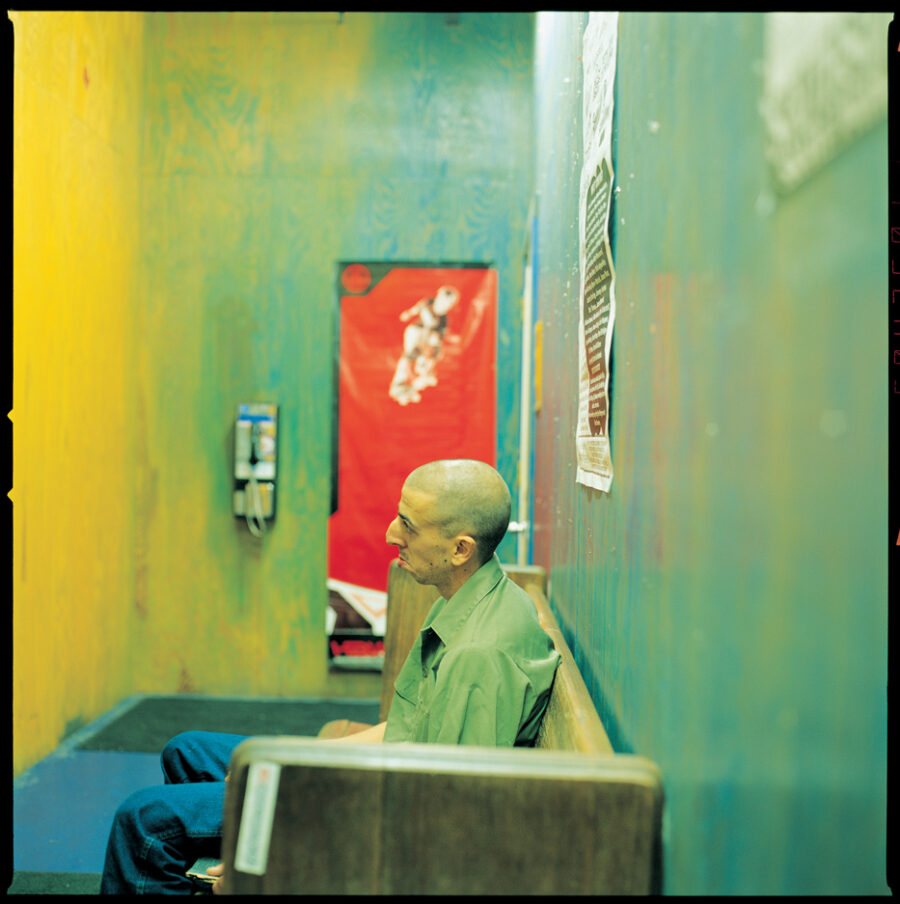
Frank Gerwer’s modelling headshot, 2003
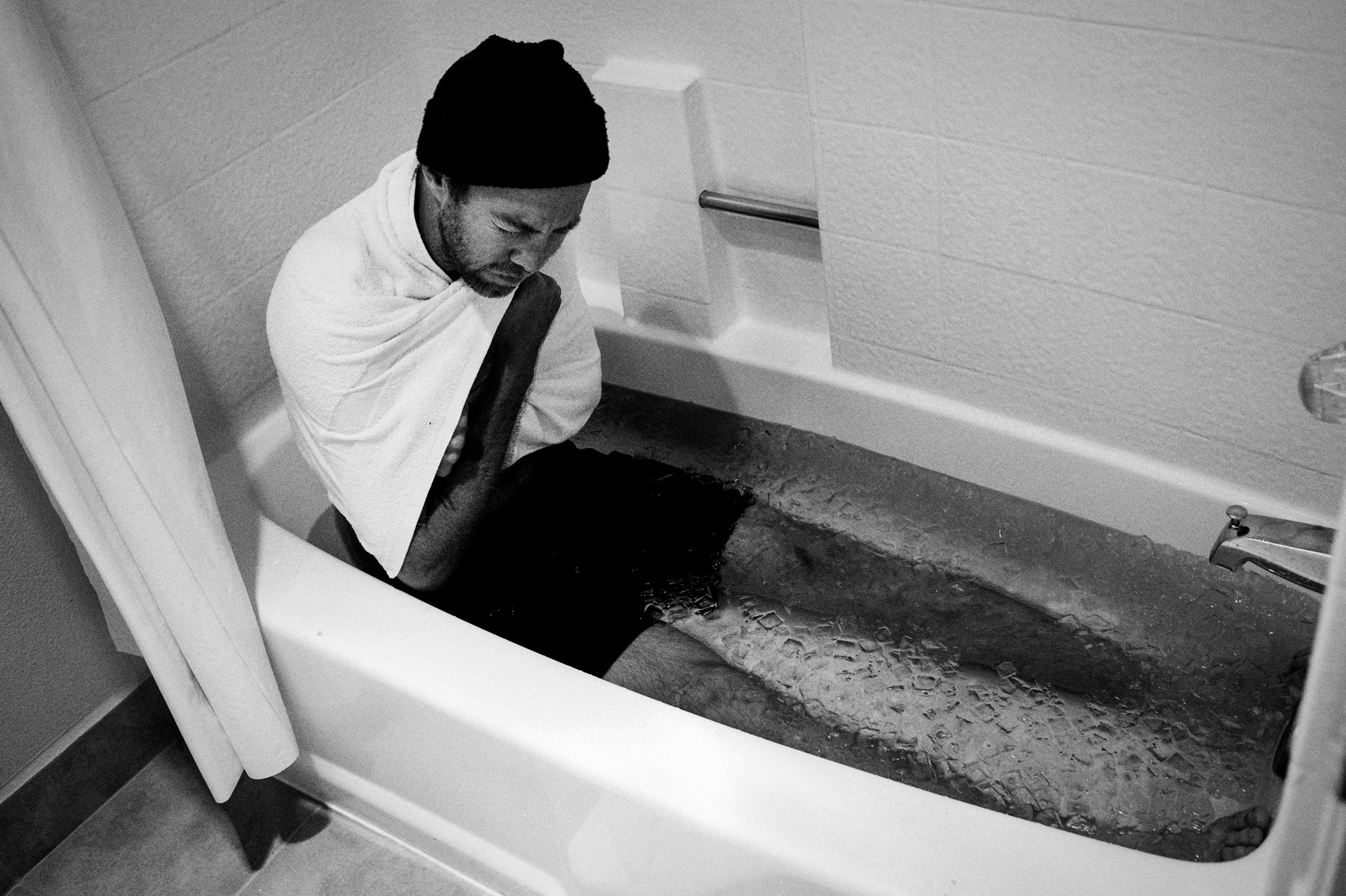
Andrew Reynolds, 2009
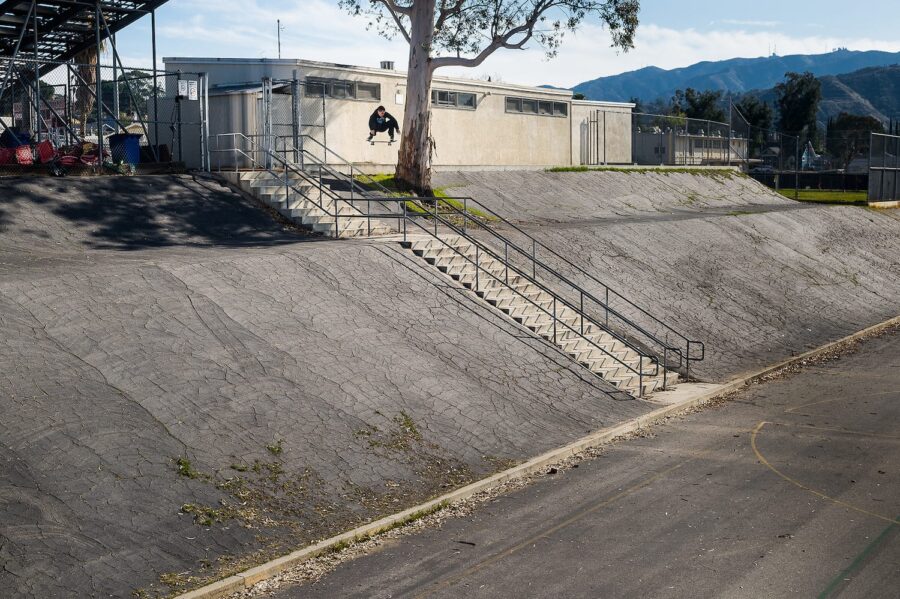
Alternate angle of Mason Silva‘s cover ollie for Thrasher #477, April 2020
“We’ll get twelve versions of a single article until we get to the finish line.”
With the mag itself, run me through the process of putting an issue together and what cogs are moving throughout?
The first thing to understand is the different parts of the magazine. We have the ‘Departments’ like ‘Somethin’ Else, ‘Five Greats’ and ‘People I’ve Known’ – all recognisable things which remain the same, then we have ‘Features’ which are trips, interviews, photo features and other one-offs.
At the beginning of the month, I have things pencilled in typically because they’re event-based like a Skater Of The Year trip, Am Scramble or a video. In that case, a company will hit me up six months prior and say, for instance, “We’re trying to put our video out in September, what do we need to do?”
“All your photos need to be here before this point and these are your photo deadlines.”
We’ll try to place as much good material as we can in support of those projects, leading up to them. For this issue, I had a couple things pencilled in but basically I have a written pagination of everything. The magazine’s also divided by the “upfront” section which is broken into “On Board” – that rapid fire, ad-editorial-ad-editorial pacing; and the “Feature Well” which has big breaks of editorial without ads interrupting. Then, the “back end” is where the music, news and so on lives and that’s more of rapid fire, editorial-to-ads again.
I have a folder on my computer called ‘Good Shit’ where I’ll pull things together as people send them in. I’ll look at the [pagination] list, see what we already have, then go check in about if whatever video is really happening because all the videos move. They almost never come out when they’re supposed to. For example, the Elijah Berle part [Alright, OK], got pushed back almost two years.
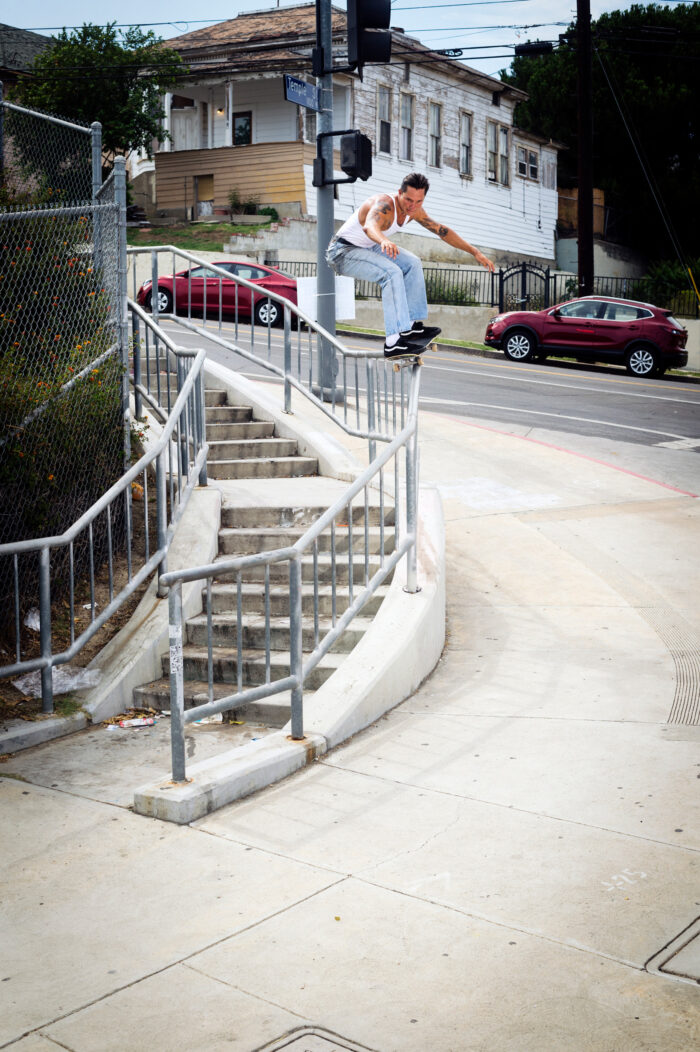
Elijah Berle frontside 5050s the Temple Rail two years past his video part’s deadline for the cover of Thrasher Magazine #485, December 2020.
So! I check back and ask, “Are these videos really happening?” When I find that out, I look at the material and decide what the best use of it is. Is this person getting an interview? A one or two page thing? The ‘Firing Line’? I’ll scale the editorial for what we have and where it’s clear someone is going to be shooting their last tricks, if I’m on it then I’ll connect to skater. If not, I’ll speak to the photographer who is and say, “Let ‘em know they’ve got three weekends. Try to get something good.”
From there, I’ll make rough edits and send low-res photo edits to the art department and photographers. I spend a whole day writing emails, saying, “Please send these photos to Cameron [Padgett], our art director.” As I do the edit, I put it in order with page breaks and basically do a very rough layout. That also lets you know what you can do because, as a designer, you’ll know you can’t run like three vertical photos on a spread. I mean, you can but it looks weird so it’s like, “Oh, you need a square one”, or “I need a landscape photo”, or “That’s too many crooked grinds!”
That helps you pace it out and see what you’re doing. Once the art dept have hi-res photos, they start spitting back rough layouts so we look at it on the page. Meanwhile, I’ll talk to our managing editor, Michael Sieben and he starts wrangling the writing. We do a lot of rewriting whilst we get the rough drafts going. Then we’ll thread the text through and see what we’re missing, how it looks, how it fits. We’ll get twelve versions of a single article until we get to the finish line.
I’ll usually have a handful of cover options so we’ll do cover mocks and that’s when I talk to Tony. He doesn’t really get involved in anything except the cover. He’s a great sounding board. The weekend before we go to press I’ll write the ‘Trash’, ‘Drop In’ – all those jokes and stuff. We get a final edit, read through it a billion times and forget to find all the typos and then that’s it. Occasionally, the ad guy will be like, “Hey, can you fill twelve pages?” so at the last minute we’ll have to figure that out. Or even worse, he’ll say we need a certain amount of pages [for ads] so I’ll have to go through, condense and cut shit.
Basically, it’s a lot of time-sensitive video stuff but I always have freestanding, timeless projects that I save and I’ll anchor the magazine with those. We did an article called ‘Over It’ about skaters and drug addiction and there’s been ‘Skateboarders In Love’, ‘Skaters With Jobs’ which are all things I really enjoy. More cultural and a departure from a dude trying to get a trick on a triple set, although that’s exciting too.
And that’s how we do it. Then there’s no break. When I go on a trip, I have to do all my work ahead of time and when I get back, I’m crushed. I could sit at my desk for the rest of my life but it’s important for me to shoot photos and be out there. That’s what got me here and that’s what’s going to keep me here: being engaged.

Nothing short of a skateboarder with a vision, Tom Karangelov slips into Thief mode in an ongoing ode to Michael Mann for his ‘Five Greats’ Thrasher interview. Below: bluntslide duck under from his corresponding ‘Cutting Corners’ video part, 2021.
How would someone go about getting either a photo or a piece of writing published these days?
 The dirty secret is we don’t have a lot of people hitting us up and I’m not inundated with writers, especially somebody with a concept or idea.
The dirty secret is we don’t have a lot of people hitting us up and I’m not inundated with writers, especially somebody with a concept or idea.
On the photo end, the biggest route to success is posse. We’ve seen this over and over again. It’s not coattail-riding but if someone is friends with the hot crew and has access to those people, that’s far and away and the fastest track. We ran a lot of sucky Tom Penny photos because it was the only way we could get Tom Penny. That’s negative but totally true.
The best way would be a combination of those things, you’re a whizz at photography, highly personable, and in the streets having a great time. The problem we have now, and it’s a good “problem”, is that we get all the photos. All of them. That exist. We’re not hurting for photos, what we’re hurting for is somebody with a vision and an idea of what they’d like to do.
“Hey, what about an article on this? Furthermore, I can shoot it. And I can write it. And I’ve got a title. What if we made a video too?”
That’s the best way: to have an editorial vision for what you want to do. To understand what the magazine is, how it works, approach us with a good idea, some level of skill and the ability to finish it. I used to tell people why their ideas were bad, then I realised you don’t even have to do that. You just say, “Yeah, do it!” and 99% of people don’t so you don’t have to bum them out [laughs].
“I’d never met another skate photographer so I was trying to figure it out from wedding photographers at the camera shop.”
Thinking of the position you were in at the start – capable, but not exactly experienced – does that career trajectory of learning on the job and ending up as part of the furniture still exist?
The “novice” level is so high compared to where it was because people have such amazing tools to figure it out. I had to learn how to shoot photos on film, with no Google, and I’d never met another skate photographer so I was trying to figure it out from wedding photographers at the camera shop. There’s nobody who would be as unsophisticated as I was because everybody is way more sophisticated now.
Print is a pretty stayed endeavour compared to video. The next visionaries are making videos. Luckily, we’re working with those guys too and building relationships with them is an important part of Thrasher. The kids seem dynamite, man. They’re geniuses [laughs].
Look at Jake Harris. How hard would it have been to connect with a kid in England, making a local video, back in the old days? There’s so much more opportunity because the tools and the communication is out there. The last several people we’ve hired, we’ve found through Instagram or met through them submitting their videos. There’s an opportunity for people to get started but, honestly, kids are just so much more adept.
I was a dunce, it’s a miracle it worked out. I remember meeting Jerry Hsu when he was 15 years old and he was the brightest, funniest, could-hang-out guy. I’d hate to see myself at 15. The kids who rise to the top in skateboarding are such dynamic people. It used to be that you had to put up with some fucking idiots because they were good at skating. You don’t have to deal with those people anymore because those guys don’t get board sponsors unless it’s something terrible.

Nora Vasconcellos’ opener from her ‘People I’ve Known’ article, Thrasher Magazine #494, September 2021
“With interviews, it’s that part of the permanent record. The real estate of: “Here are my pages.” I try to make them as classy as possible, especially for the legends.
Covers are an obvious milestone but ‘The Thrasher Interview’ still holds a lot of weight. I interviewed Andrew Allen a while back and he said he wants to score both in one issue before he calls it a day. Why do you think the interview format resonates in such a way?
Maybe it’s the LP album of skate media. It’s tactile. People are still jazzed on the cover because they understand the mythology of “I got the cover” if it was Rolling Stone or something, you know?
With interviews, it’s that part of the permanent record, the real estate of “here are my pages.” I try to make them as classy as possible, especially for the legends. Like, “I’m interviewing Anthony Van Engelen. How’s this going to look?”
I love that people revere it and take it seriously. I do too.
On that note, ‘Heroes and Heavies’ and reigniting ‘People I’ve Known’ has made for some of the best Thrasher articles in the last couple of years. How do new formats for stories come to be?
With those, it’s trying to do something besides a straight Q&A interview and part of that is adding visual flourishes to it. I feel the straight Q&A is hard to digest, especially with younger generations who don’t seem to read anything but Instagram. We still do Q&A interviews every month but ‘Heroes and Heavies’ and ‘People I’ve Known’ are a way to mix it up.
Funny stories are my favourite so I wanted to kickstart ‘People I’ve Known’ because it cuts to the chase. Totally indulgently, I did one myself because they’re so much fun. ‘People I’ve Known’ was originally done with Jason Jessee in the mid-90s. I always liked it and a few years ago, Corey Duffel wanted to work on another interview.
“Corey, you’ve had too many straightforward interviews. What do you think about this?”
He let loose. Score settling, talking shit, feeling sorry for himself – it was fantastic! He knocked it out of the park. No filter, straight Corey Duffel style. I got Mike Sinclair to do one, then people just asked to do them. Andrew Allen has one that’s feature length in the new issue. Here’s what you can do with a magazine: make your own rules. This thing was four pages to begin with. Andrew was unsure how he wanted to go around the interview so I was like, “Well you can just have a ‘People I’ve Known’ and make it feature length.” We have another with Bobby Worrest coming up. I’m trying not to be lazy and come up with things that are fun and I want people to actually read it.
I don’t want to do the ‘road trip’ article anymore. Unless you have a talented writer, they’re turds. By virtue of you and your crew driving the next state over, it’s just not newsworthy anymore. Not to be too negative about that but I just want to make the whole magazine as something to share. That’s important to me because I love reading, little jokes and knowing about what these guys are into. ‘Heroes and Heavies’ is virtually the same thing, just a more serious version.
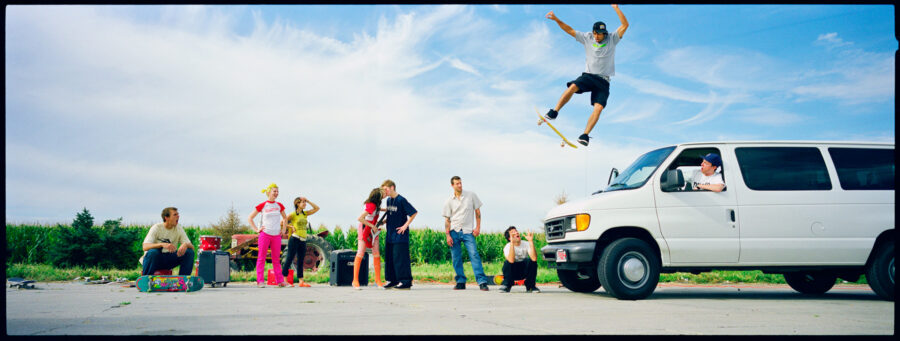
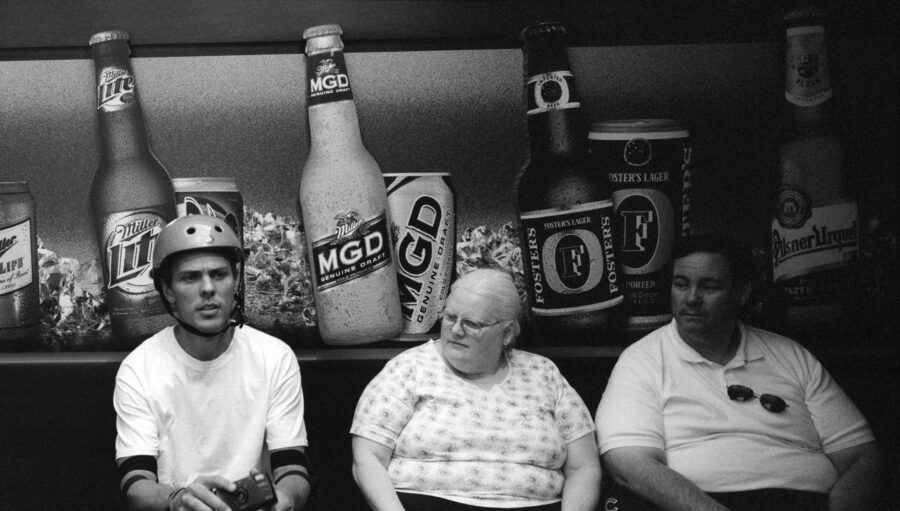
The Girl crew and Rick Howard during King Of The Road, 2004
“The kid who dreams of being on the Olympic stage and the kid who dreams of butt-chugging are probably very different.”
Having previously discussed your thoughts on how skateboarding doesn’t necessarily need to reach the widest audience imaginable, what’s your take on the type of exposure Thrasher gained through Vice broadcasting King Of The Road?
The way most people try to get skateboarding to the mainstream is in the contest format – which is contrived. I don’t make the rules but, to me, skating is fast, loose and improvisational. The Olympics looked like gymnastics. Obviously they’re really skilled but one at a time, at a single obstacle? That’s more tame than old comps with Rodney Mullen doing freestyle.
When the X-Games started, nobody wanted to go. It was Eric Koston and a bunch of Brazilians. Their whole storyline was absurd – training up and getting the energy drink sponsor, but they said it enough and people believed it. That even became reality for some.
King Of The Road is what I like about skateboarding. Jokes, goofing around, big tricks, and getting to know skaters. The whole idea, before the TV show, was manipulating it to have the greatest road trip of our lives. People don’t really care who wins or loses. While yes, that got out to more people – and I’ve had many awkward encounters in airports since, I stand behind that vision of skateboarding because that’s what I love. It’s a heightened version but it’s based on everything I like.
The kid who dreams of being on the Olympic stage and the kid who dreams of butt-chugging are probably very different.
Earlier on, you mentioned that Geoff Rowley was an important part of your own journey at Thrasher and I remember you’ve also talked about how the Europe-heavy Sorry era played into modernising the mag. Do you see Tom Knox and Atlantic Drift as a similar gear change?
Definitely. It’s a different vibe but you can’t help but take it internationally. If you look in the next mag, half of it’s Europe.
England, you guys are locked inside, drinking tea, coming up with great ideas and when you have the opportunity to get outside, it goes bananas. I like the campier Thrasher stuff but I also like that Thrasher, and what it is, can evolve with different crews. It’s not just “frontside air in the bowl.” I don’t think people think about it that way now, particularly, but that was the joke.
I love all that stuff but the idea of Tom Knox as “a Thrasher guy” is also what we’re about. It’s not chasing trends, it’s recognising creativity.
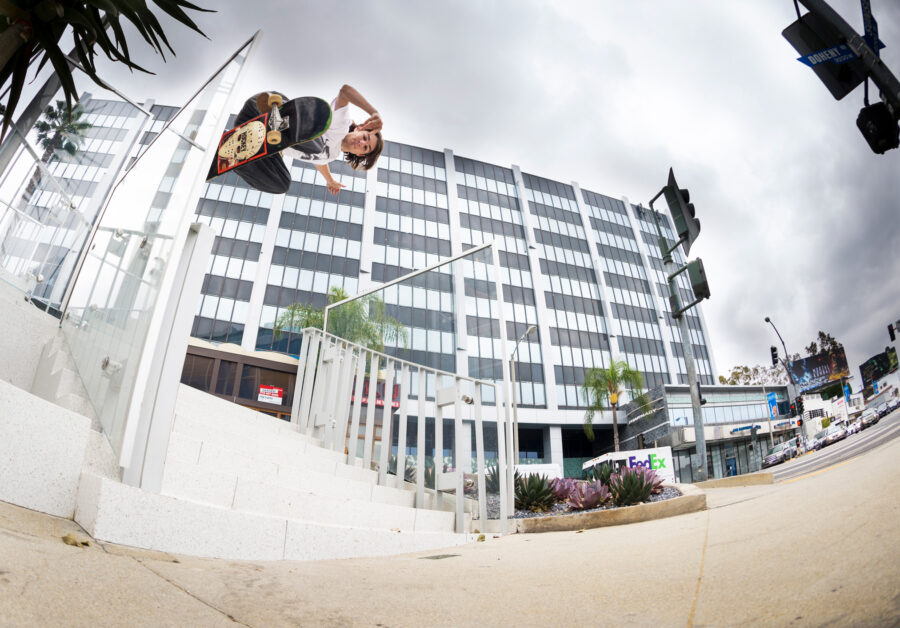
Shane Farber, backside wallride, 2021
“A video of some kids you’ve never heard of is often just as good as some company video that just came out.”
Is a long term ambition to have an equivalent crew in as many countries as possible?
I think so. We have Gronze, we have stuff going on with some Australian guys. You can peak into these scenes, it’s so killer. The scary thing is realising how many ripping skaters are out there. A video of some kids you’ve never heard of is often just as good as some company video that just came out.
In the ‘80s, it’d be like if you had a camera at Del Mar, at Tony Hawk’s house, in Neil Blender’s backyard, over here with Natas Kaupas and then Gonz is over there too. You can do that now. You can see it. Plus, it’s like an art form infused with their sensibility and set to music. Which, with Atlantic Drift, happens to be brooding, ‘90s goth music, somehow.
Like I said before, video is where the creative geniuses are going. You get to make these mini-opuses, a love-letter to you and your friends, and it’s fucking magical. For us it’s super important. I don’t know that every video series will turn into a t-shirt brand but as far as connecting, and people feeling like Thrasher is the place to do that, that’s such a success for us. It makes me feel good about what we want to do because I don’t want to be shilling for the advertisers nonstop. I was never a pro skateboarder and none of my friends were. Skateboarding is bigger than sponsors.
It’s super cool and bring it on. Where’s the crew from Tasmania?
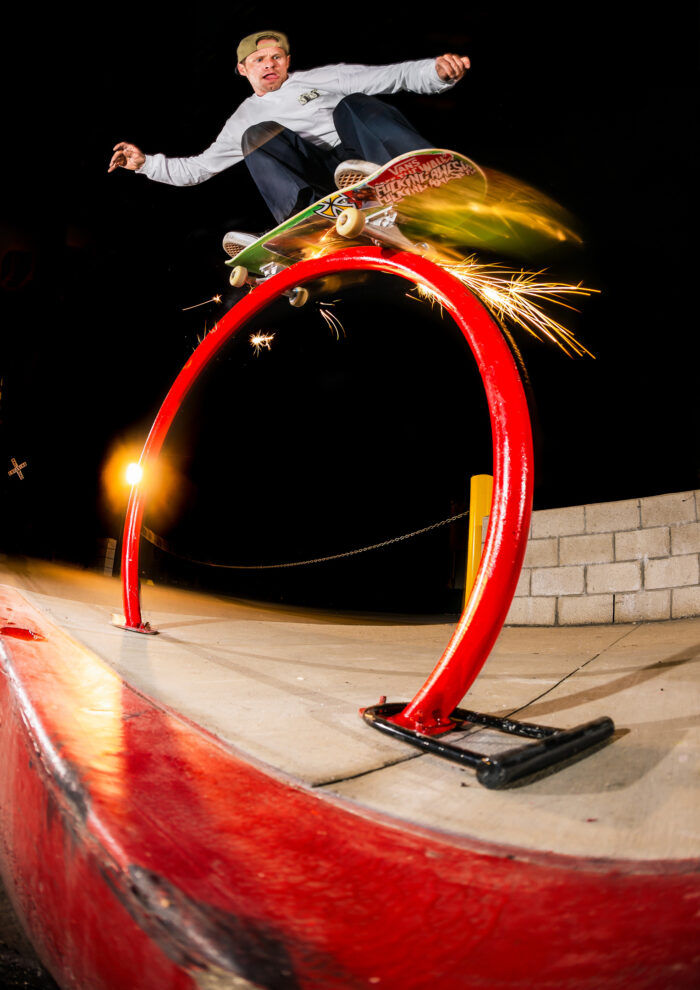
“I’ll tell what Jake said: “Over the mountain – he’s in!” A.V.E. sparks a bike rack for his Skater Of The Year cover, Thrasher Magazine #429, April 2016. Below: Anthony’s boy, Jason Dill also jams over a round thing during the Propeller era.
This interview is going out in prime Skater Of The Year season so I thought we’d wrap up with the story behind your photo for A.V.E.’s cover, as you also sent over an outtake that’s pretty spectacular, and talk a little on how S.O.T.Y. plays into the publishing process. How far back do you and Anthony go?
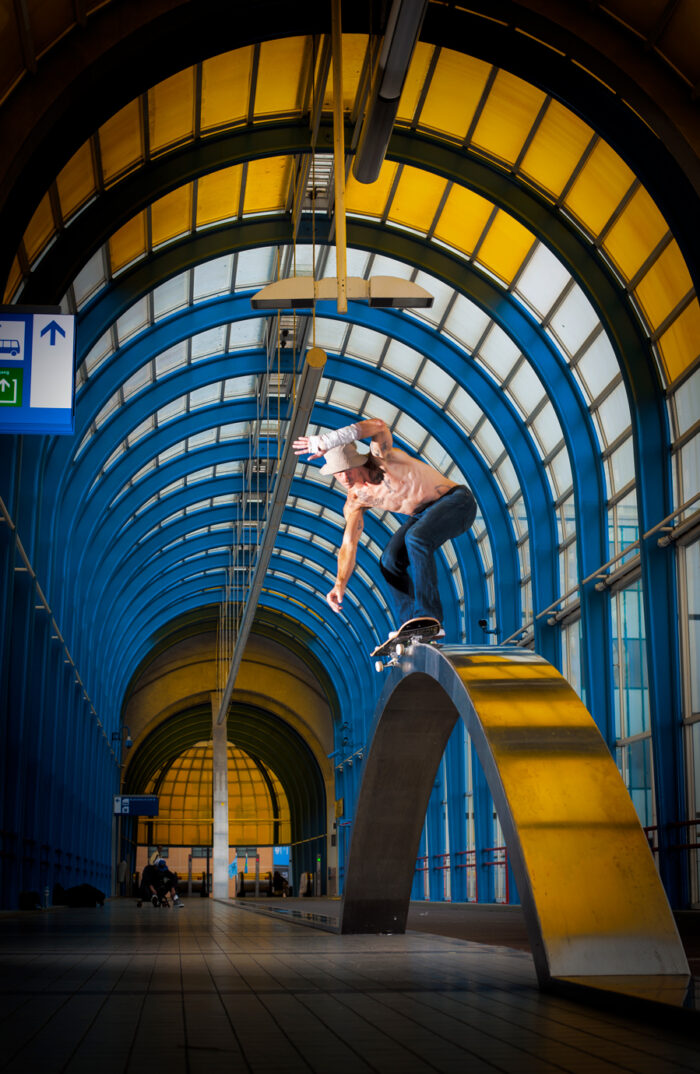 When I got the job, I only knew a couple of people in California. One was my friend, Andy Harris who I went to live with in San Pedro and he’s the guy who built the Channel Street DIY park. The others were two friends I went to school with and they started Elwood Clothing and 23 Skateboards. So, amongst the first few pro skaters I ever met were Dill and A.V.E. but A.V.E. was an amateur. I have a couple of early photos of them.
When I got the job, I only knew a couple of people in California. One was my friend, Andy Harris who I went to live with in San Pedro and he’s the guy who built the Channel Street DIY park. The others were two friends I went to school with and they started Elwood Clothing and 23 Skateboards. So, amongst the first few pro skaters I ever met were Dill and A.V.E. but A.V.E. was an amateur. I have a couple of early photos of them.
It’s not like we were tight or became fast friends but they were some of the first pro skaters I shot photos off. Starting with Vans trips for Propeller, I met up with him to shoot an interview. That’s when we connected the most we have. He always says “my boy”. We’re friendly but I wouldn’t say we’re “boys”. Although I have been to his home, socially [laughs].
This was shot and ran after his S.O.T.Y. announcement so what’s the process of producing one of those covers? If a standout photo passes through Thrasher, as the decision is being made, will you keep it in reserve or does everyone start from scratch?
It’s usually the latter. In the modern era, winning it means there’s a giant video build up leading to that decision – as you may have noticed [laughs]. You’ve put out big video parts, had your big interview and you’ve had your Thrasher cover already and that’s part of what gets you it. Typically, the Skaters Of The Year aren’t sitting on a lot after we’ve announced they won. We joke about it all the time.
We’re actually working on a S.O.T.Y. book so I’ve been digging in and doing some research. The first was Tony Hawk and – long story short – Skater Of The Year has evolved as far as how it’s billed. We used to have you win and then that skater would be forced to jam out a new interview and a cover over a three-and-a-half week period. When I got the job, Eric Koston had just won. They sent me out to shoot with him and it was pretty miserable. Ultimately, Luke Ogden flew down and shot that nosebluntslide on the Venice hubba a day before they went to press.
That was what I inherited and then my time at the magazine really built up the Skater Of The Year because it walked in line with everybody getting organised with how videos and materials were released. Once videos went online, that became a whole other thing.
Anyway, I said, “Wouldn’t it be more fun if we had these guys go on a trip and let them pick who gets to go?” then that would be the article. Now, it’s like, “You won, so you get to do a fun* trip with your friends.” But it’s fun with an asterisk because I don’t know exactly what’s “fun” for A.V.E. [laughs]. Pressure to perform is definitely not on that list.
“You won, so you get to do a fun* trip with your friends” – but it’s fun with an asterisk because I don’t know exactly what’s “fun” for A.V.E.
Pressure to perform is definitely not on that list.”
Chasing Green Benches around California, high on that list in my experience of talking to him…
[Laughs] I think he was happy to win S.O.T.Y. and we did the whole thing where Cody Green [F.A. and Hockey filmer] dressed up as the life-size Rusty trophy. That was super fun, then it was like, “Where do you want to do your trip?”
Dude, he’s the king of leaving the trip after the first eight hours. That was totally not how he’d choose to operate. We went to Hawaii, brought his friends and in my mind we had fun. Last week I went shooting with Big John [Fitzgerald] and, amongst themselves, they talk about it like it was some sort of death march on an island. A.V.E. definitely didn’t see it as a “fun vacation”, he was stressed out the entire time. It wasn’t the right fit, we should’ve just left him alone [laughs]. He was a good sport about it – thanks very much A.V.E., but it’s not how he would’ve wanted to do it. We got back and didn’t have a cover.
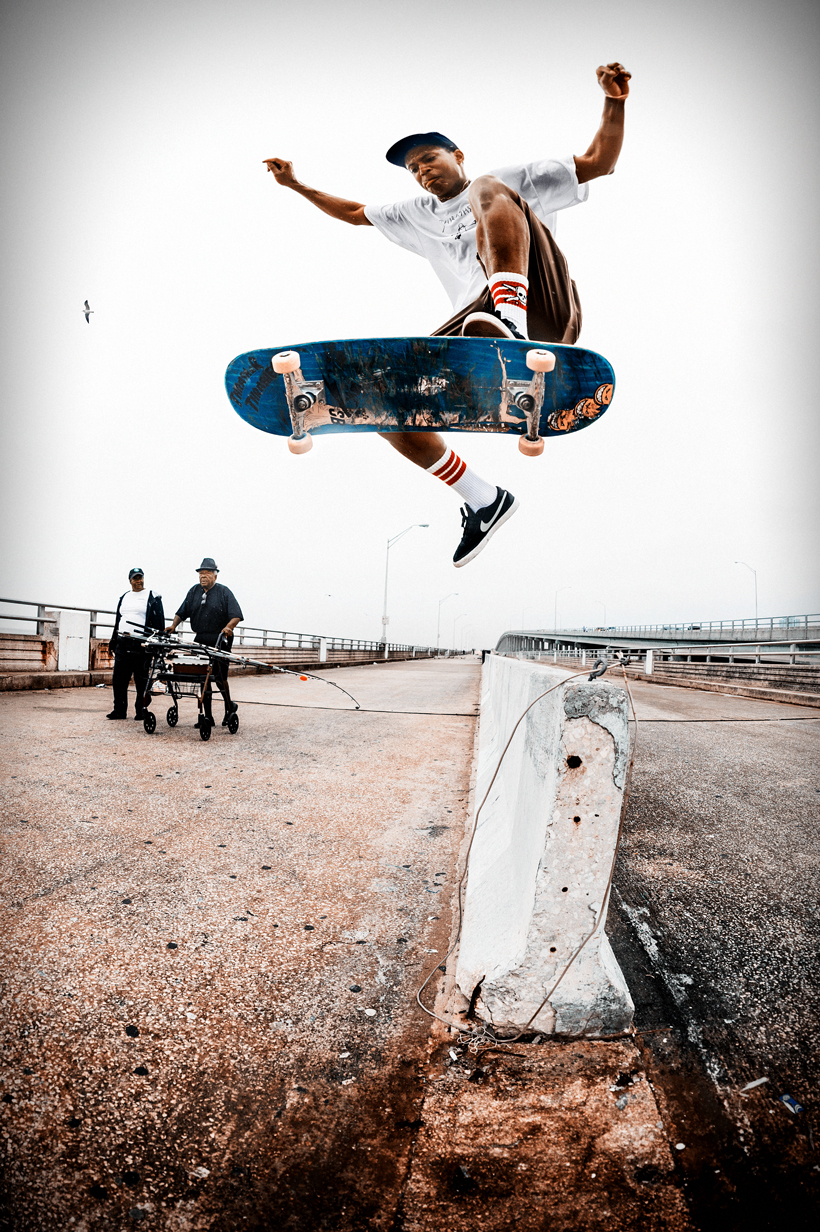 I said, “Let’s just do something cool-looking,” and pitched a few ideas. I don’t know how much time you’ve spent around the old halfpipe but there’s nothing more exciting than setting that coping on fire. As you can see from the outtake. We tried a few variations and ultimately decided on the sparks.
I said, “Let’s just do something cool-looking,” and pitched a few ideas. I don’t know how much time you’ve spent around the old halfpipe but there’s nothing more exciting than setting that coping on fire. As you can see from the outtake. We tried a few variations and ultimately decided on the sparks.
I figured the sparks came first because the flaming version has what looks like gasoline on the floor.
That sounds right. Here’s how you know if you’ve done a good cover: how many people draw pictures of it. The Ishod [Wair] no-comply over the barrier which is in the same spirit of bold, iconic images – people draw the shit out of that and people draw the shit out of the sparking hoop. That’s a good measure of if your cover was successful or not, do the kids draw pictures of it? And by “the kids” I mean up to and including 45 year old men.
How’d you get it to spark?
I called Lance Mountain. He’s the king of it and knows every trick in the book. You buy flints, drill holes in your trucks using a drill bit that’s the same size as the flint, then you drop ‘em in with a bit of glue and you get a sparking truck. They’ve been doing it since the ‘70s. I’ve done it with Lance at his pool before. When I was doing this, I don’t know which was cooler. Now I look back and think, “Maybe I should’ve gone with the flames?” It wasn’t like we were trying to fool anyone.
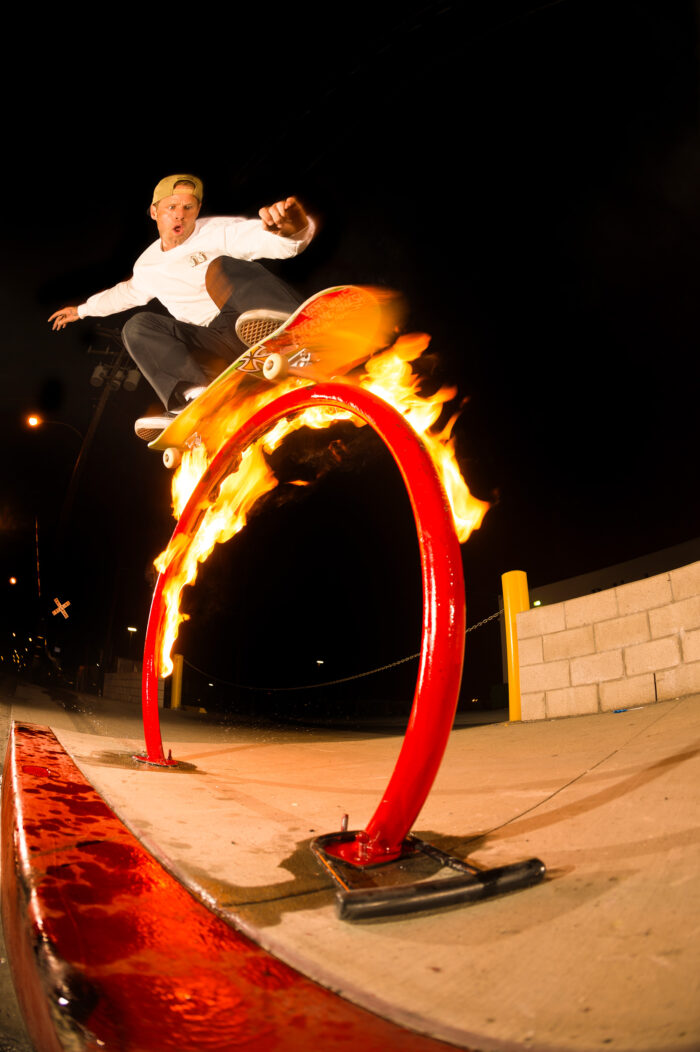
Alternate version of A.V.E.’s SOTY cover, 2016. Above: Ishod Wair’s SOTY cover photo, April 2014
“He’s real funny in his misery, he reminds me of Indiana Jones.”
Considering the events of that Hawaii trip, I’m sure he loved that kind of preparation [laughs].
He’s the coolest, man. He’s real funny in his misery, he reminds me of Indiana Jones. He’s such a tough guy, he’s up for whatever, but is often so miserable throughout in a very funny way. He’s a super nice guy and that was his last official duty for the mag. I joked about it and I’m not sure if he’s had a photo since.
I don’t remember it being super hard for him either, he was just jamming over it. Also, you know you want a tip of the hat to the stuff he’s iconic for. He was one of the first, big “over the back” guys.
Yeah. With the bright red there’s also an echo of that Columbus Park rail too. He capped off that spot with his Propeller ender, and that was his previous cover, so this photo fitting if you wanted to read it that way.
For sure. This was the right fit, given the time constraints and the mental state of the Skater Of The Year [laughs]. It’s one of my favourite covers, I love it! Everything was going bigger and that’s cool too but you lose the skater once you get up to 28 stairs, as far as a cover image goes. A big challenge is trying to capture compelling skating whilst being physically close enough to the skater to photograph them.
This occurred to me for Ishod’s S.O.T.Y. cover because he backside noseblunted Muirlands, which is one of the big rails from the Zero days, on a whim before the trip. But all tradition would tell you that’s your cover. Then he did that no comply over the barrier and I just loved the details. They’re more like ‘90s photos. Now, it’s kind of a staple but at the time, I hadn’t really seen that. Anyway, the point is that with a lot of the best covers, the skater is really big on the page. There are exceptions but that’s a good rule of thumb. It’s a struggle to try to match the magnitude of the streets, it’s always tricky
Anthony, I mean the pull quote in his Thrasher interview was, “I feel my absolute best when I’m totally fucking destroyed from skateboarding.” He loves it. He’s got nothing to prove but it’s his passion. I think he’s driven by that but it’s touching to see him start a family and have all the success he has. He’s one of the greats.
Shop the Thrasher X Slam City collection here and learn about the background of our collaboration here.
Related: Jake Phelps Interview: “It’s called gumption, elbow grease”
Previously by Farran Golding: Justin Henry – Doing It From The Home State, LIGHTBOX: Jake Johnson by Jon Menhring, ‘Lineage’ with Tom Knox, Mason Silva Interview, Rowan Zorilla Interview, LIGHTBOX: Gino Iannucci by Ben Colen, Andrew Allen Interview, Bobshirt’s Tim Anderson, Mark Suciu Interview

